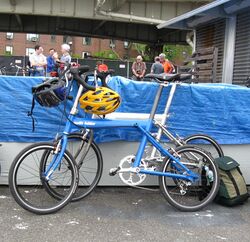Engineering:Swift Folder
The Swift Folder is a folding bicycle, designed by Peter Reich of Design Mobility Inc. of Brooklyn, New York, in collaboration with Jan VanderTuin of the Center for Appropriate Transport in Eugene, Oregon.
The Swift Folder is available from Design Mobility as a bare frame for customers to build up themselves, or assembled into a complete bicycle to the customer's requirements. From 2004[1] to the end of 2016, a mass-market version of the bicycle was sold under license by Xootr as the Xootr Swift, fully assembled to a standard specification, in single and 8-speed models.[2]
Folding System
The Swift Folder design employs a vertical folding method, using the seat-post and a split seat-tube as the locking mechanism.
To fold, the seat-post is released from the two parts of the seat-tube by their respective quick release clamps, then pulled up into the upper part of the seat-tube to unlock the frame. A pivot in the main frame tube then allows the rear triangle (comprising the seat-stays, chain-stays and the lower portion of the seat-tube) and rear wheel to swing down and forward under the main tube. The seat-post is then slid back down through the upper part of the seat-tube to lock the rear wheel in the folded position.
To unfold, the seat-post is again pulled up to allow the rear triangle to swing back and up into the normal riding position. The seat-post is then slid down through the upper and lower parts of the seat-tube, locking the rear triangle and wheel into place.[3]
The Swift frame is simple and robust, and allows a quick fold, but when folded is not as compact as some other folding bicycle designs. The bottom bracket forms part of the folding rear triangle, and as a result the bottom bracket to rear fork-end distance remains constant throughout the fold. This keeps the chain tension constant, which is an advantage when the Swift frame is used in a fixed-gear, single speed, or hub gear bicycle.
Construction
There are two Swift Folder frames, one is low-volume Chromoly manufacturing by Human Powered Machines of Eugene, Oregon, which also makes work bikes and trailers; the other, manufactured in Taiwan from TIG welded aluminium alloy with a "chromoly" steel fork, was marketed by Xootr.[1] The frame is generally built to common "industry-standard" sizes and threads, and can accommodate a wide variety of gear systems, brakes and other components. The rear fork spacing can accommodate most standard road and mountain bike wheel-hubs.
The Swift Folder is normally fitted with "20 inch" wheels. The standard ISO 5775 wheel size is 406mm (traditionally known as 20x1 to 20x2.125), the same size used on most BMX bicycles. A wide variety of wheels and tires are available in this size.
The Swift Folder is also designed to work with 20 inch 451mm wheels. The linear pull brakes that come standard with the Swift will not work with 451s. The frame is designed to work with Caliper brakes with the larger wheels.
Reviews
Reviews of the Swift have generally been positive. The Swift has been praised for its responsive, comfortable ride, its stiff frame, its light weight, its low step-through height, and its use of standard as opposed to proprietary parts for the components. This includes the wheels, tires, handlebars, seat, shifter, brakes, chainring and cogset, all of which can easily be replaced. Reviews usually call out the large folded size and cumbersome folded shape as a disadvantage. It is sometimes also pointed out that the Swift doesn't stand when folded. There was some disagreement as to whether its price was high for the range, though commentary on that point tended to be muted as the price for the Xootr Swift was generally in line with mass market folding bikes.[4] [5] [6] [7] [8] [9] [10]
Given the generally positive reviews and the competitive price, it is likely that the large folded size was the sticky point for many buyers, as many more bicycles with higher pricetags and smaller sizes have been sold.
References
- ↑ Jump up to: 1.0 1.1 "Story". http://www.swiftfolders.com/swift/Story.html.
- ↑ Models - Swift Folding Bicycle (showing the beginning of the clearance at the end of 2016), Xootr, archived from the original on 2016-08-31, https://web.archive.org/web/20160831102650/http://www.xootr.com/swift-folding-bicycles-models.html
- ↑ YouTube video of Xootr Swift folding and unfolding
- ↑ Review: Xootr Swift, Adam Newman, Bicycle Times, April 12, 2011, http://bicycletimesmag.com/review-xootr-swift/
- ↑ The WTF! Show Live: Xootr Swift folding bicycle review, Mr Brown of The WTF! Show, youtube, October 31, 2008, https://www.youtube.com/watch?v=B_gKzd6CCS8
- ↑ Xootr Swift Folding Bicycle, AVWeb, youtube, June 20, 2012, https://www.youtube.com/watch?v=CP2juK_y5dE
- ↑ Xootr Swift Folding Bike, Folding Bike Zone, https://www.foldingbikezone.com/xootr-swift-foldable-bike/
- ↑ Xootr Swift Folding Bike, Rugged Reviews, Larry Richardson, December 2009, archived from the original on 2015-02-19, https://web.archive.org/web/20150219121750/http://www.ruggedreviews.com/Xootr%20Swift.html
- ↑ Xootr Swift Folding Bike, 'thew's Reviews dot Com, Matthew Robertson, July 27, 2009, http://www.thewsreviews.com/2009/07/xootr-swift-folding-bike.html
- ↑ Xootr Swift: Two Years Later, 'thew's Reviews dot Com, Matthew Robertson, July 27, 2011, http://www.thewsreviews.com/2011/07/xootr-swift-two.html
- A to B Magazine Feb/Mar 2001
- New York Magazine July 28, 1997
External links
- Swift Folder home page.
- Human Powered Machines CroMoly Swift Folder page
- Xootr Swift Component Specifications.
 |



